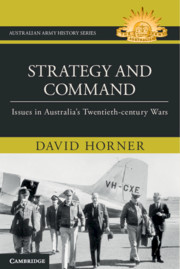Book contents
- Strategy and Command
- Other titles in the Australian Army History Series
- Acknowledgement of Country
- Strategy and Command
- Copyright page
- Contents
- Figures, maps and tables
- Preface
- Acknowledgements
- Abbreviations
- Introduction
- Chapter 1 The influence of the Boer War on Australia’s First World War commanders
- Chapter 2 Preparing for war, 1901–14
- Chapter 3 The AIF’s commanders
- Chapter 4 Strategic planning between the wars
- Chapter 5 Identifying the threat from Japan in 1941
- Chapter 6 A pivotal year in Australian history: 1942
- Chapter 7 Australia and coalition warfare in the Second World War
- Chapter 8 Deciding Australia’s war strategy in 1943
- Chapter 9 Advancing national interests
- Chapter 10 Higher command in the Korean War
- Chapter 11 Higher direction of the army in the Vietnam War
- Chapter 12 The Gulf War, 1991
- Chapter 13 Deploying and sustaining INTERFET in East Timor in 1999
- Chapter 14 Developing a command structure for joint operations
- Notes
- Bibliography
- Index
Chapter 3 - The AIF’s commanders
Learning on the job
Published online by Cambridge University Press: 08 October 2021
- Strategy and Command
- Other titles in the Australian Army History Series
- Acknowledgement of Country
- Strategy and Command
- Copyright page
- Contents
- Figures, maps and tables
- Preface
- Acknowledgements
- Abbreviations
- Introduction
- Chapter 1 The influence of the Boer War on Australia’s First World War commanders
- Chapter 2 Preparing for war, 1901–14
- Chapter 3 The AIF’s commanders
- Chapter 4 Strategic planning between the wars
- Chapter 5 Identifying the threat from Japan in 1941
- Chapter 6 A pivotal year in Australian history: 1942
- Chapter 7 Australia and coalition warfare in the Second World War
- Chapter 8 Deciding Australia’s war strategy in 1943
- Chapter 9 Advancing national interests
- Chapter 10 Higher command in the Korean War
- Chapter 11 Higher direction of the army in the Vietnam War
- Chapter 12 The Gulf War, 1991
- Chapter 13 Deploying and sustaining INTERFET in East Timor in 1999
- Chapter 14 Developing a command structure for joint operations
- Notes
- Bibliography
- Index
Summary
It was inevitable that the commanders of the Australian Imperial Force (AIF) would be learning on the job. This was not just because the nature of the war could not have been anticipated and proved an overwhelming challenge for the commanders of all the armies involved; it was also because at the outbreak of the First World War the Australian Army was still in its infancy and relied heavily on the British Army for its ideas and direction. As Australia was a member of the British Empire, the AIF operated as part of the British Army. Further, the Australian forces were deployed by the British high command without consulting the Australian Government, and the commander of the AIF did not believe that it was his role to become involved in higher level questions of strategy. Even at the lower operational levels, senior Australian commanders were not willing, at first, to challenge the orders issued by their British superiors. Much of this would change during the war.
Keywords
- Type
- Chapter
- Information
- Strategy and CommandIssues in Australia's Twentieth-century Wars, pp. 45 - 68Publisher: Cambridge University PressPrint publication year: 2021

